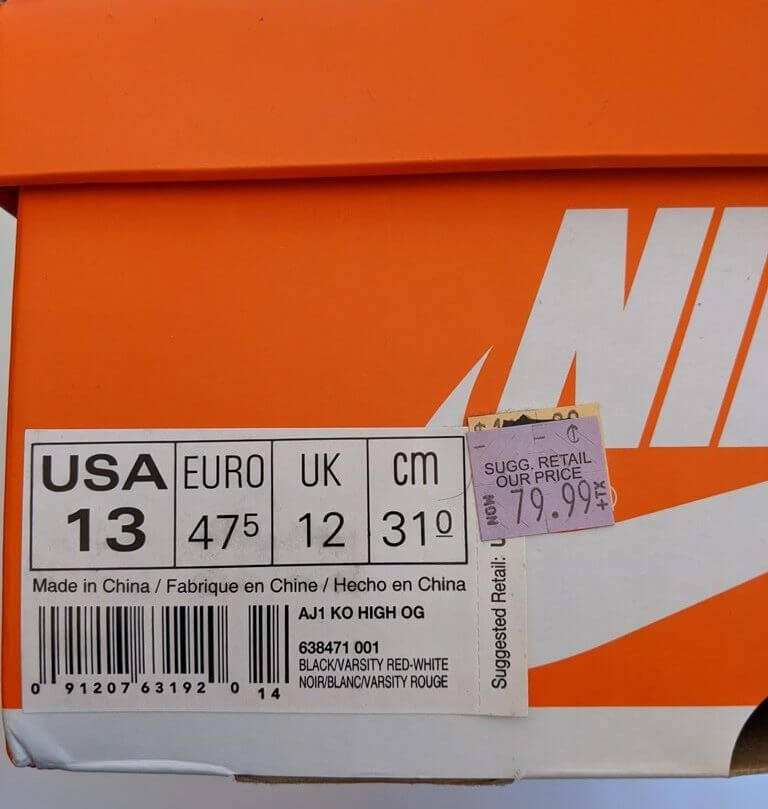![]()
If you’ve ever wanted to know why sneaker culture gets discounted where it matters the most, it’s because of the artificial hype created by limited release products and consumers who covet only what they can’t have. It would appear that you could replace sneaker culture with any form of art or product, but the reality is you can’t. Place art in there and it doesn’t work because a work of art is created once and then an artist may create giclees, but those are hand embellished. Those aren’t sneakers made 100 – 100,000 times over. The demand lacks logic and because it does, building a business based on limited release product and scarcity is a very difficult model to maintain without a considerable amount of money behind the product.
In these two pictures are the Air Jordan KO in Bred. The original price of the retro was $140.00 when it released. The shoe sat on shelves back in 2012, 2014 and 2015. The style, even in the Bred color here, ended up on deep discount at Nike Clearance Stores and at City Gear Outlets the shoe could be found in a variety of colorways at 69.99, buy one get one for a dollar. Prior to the quarantine and Covid, the blue, and the grey quilted AJKOs were still showing up in Clearance Stores after sitting for three years!

What changed from 2015 to today?
Was it a new round of sneaker enthusiasts who were only 12 or 13 six years ago?
Was it Jordan Brand’s data from those releases that gave the brand the information needed to create just the right amount to drive the $200+ price for resale on the May 12, 2021 release?
I’m choosing the latter. Sneaker culture isn’t really about uniqueness and originality anymore. It hasn’t been for a very long time. When I made Sho-Shot basketball shoes and ARCH sneakers, it was because I wanted to create my own brand. In 2004, most of the thought leaders of today in sneaker culture were looking to be a part of what already existed, they still are. They worked for brands and for the start-up sneaker community that was born in the early 2000s. I could have worked for a brand, but I had been raised in a culture that celebrated finding something unique. I thought I could replicate that in the 2000s, but what I encountered was laughter, sneak dissing and not a single one of the websites that are huge now would write about my brand back then, they still wouldn’t. Browse most sneaker sites and the same conversation is taking place on every channel.
I created kicks because I love sneakers, but I was alone. That feeling of aloneness in this culture that I had, but fought through, was the exact opposite of what has contributed to today’s monolithic sneaker culture.
There is a statement on Robert Glasper’s Black Radio album in a spoken section by Michael Eric Dyson:
The irresistible appeal of Black individuality – where has all of that gone?
The very people who blazed our path to self-expression and pioneered a resolutely distinct and individual voice have too often succumbed to mind-numbing saneness and been seduced by simply repeating what we hear, what somebody else said or thought and not digging deep to learn what we think or what we feel, or what we believe
Now it is true that the genius of African culture is surely its repetition, but the key to such repetition was that new elements were added each round. Every round goes higher and higher. Something fresh popped off the page or jumped from a rhythm that had been recycled through the imagination of a writer or a musician. Each new installation ore the imprint of our unquenchable thirst to say something of our own, in our own way, in our own voice as best we could
The trends of the times be damned. Thank God we’ve still got musicians and thinkers whose obsession with excellence and whose hunger for greatness remind us that we should all be unsatisfied with mimicking the popular, rather than mining the fertile veins of creativity that God placed deep inside each of us
You can replace music with sneakers in that section above, and unlike art, it fits perfectly.

